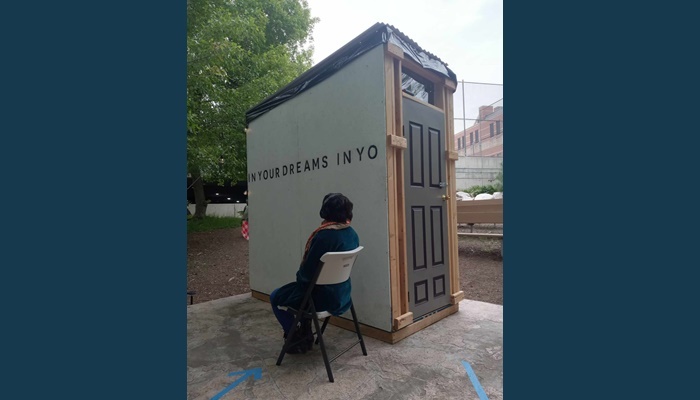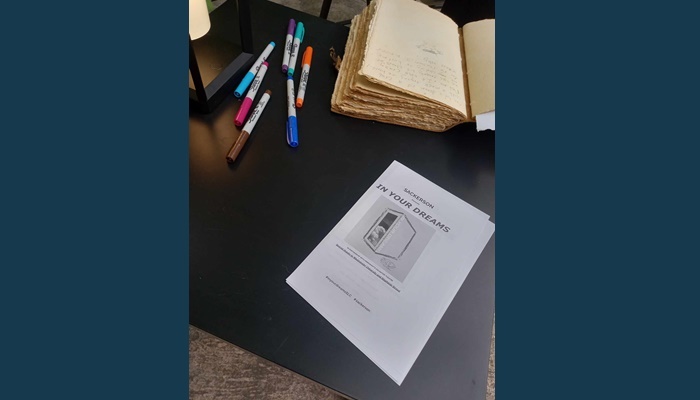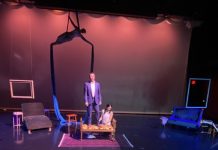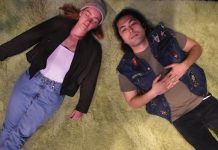
SALT LAKE CITY, Utah, May 10, 2024 (Gephardt Daily) — As the demand for housing continues in Utah, it’s an interesting time for the arts as theater companies large and small vie for space in an increasingly crowded and unpredictable market.
But whatever happens in more conventional theaters, the experimental company Sackerson will always have a home, as it thinks both outside and, in this case, inside the box. The company has become known for pieces that are pretty much the opposite of a typical theater production where the audience sits in rows of seats, facing a stage, watching actors that are fairly far away, with the very safe and non-threatening fourth wall between them.
“New works, unconventional spaces, bold audiences” is Sackerson’s simple but effective mission statement. Let’s look at the company’s three shows before this current one, “In Your Dreams,” as examples.
In summer 2019, the company presented “Hindsight,” written by Scottish-American playwright, producer and director Morag Shepherd, one of Sackerson’s co-founders and its resident writer. An audience of six people maximum, wearing headsets, followed the play through various indoor and outdoor Salt Lake City locations, such as a Utah Transit Authority bus and a downtown pizza parlor.
Then in fall 2019, the company produced “A Brief Waltz in a Little Room: 23 Short Plays about Walter Eyer” at Utah Arts Alliance’s Urban Arts Gallery in The Gateway. In this show, each individual moved through 10 tiny rooms (former Anthropologie dressing rooms) in randomized order, ultimately seeing 23 scenes total, written by Shepherd, Matthew Ivan Bennett and Shawn Francis Sanders.
Then in fall 2020, Sackerson presented “Cherry Wine in Paper Cups,” also by Shepherd, billed as an “intimate outdoor play for socially distant audiences.” The piece was performed outdoors at Library Square and audience members again listened through headphones. The run of these shows is usually longer than the conventional three-week production schedule often used by companies here, because of the small audience sizes and unconventional performance spaces that allow runs to be extended.

Now, after a 3 1/2-year break, Sackerson is back and smaller than ever, with a show produced in partnership with Immigrant’s Daughter Theatre, which was co-founded by Shepherd in 2021. “In Your Dreams” presents eight short plays by four writers, performed by three actors for six audience members at a time.
The show, written by Shepherd, Bennett, Ariana Farber, and Jesse Nepivoda, opened May 3 in the Malmsten Amphitheater space on the campus of Westminster University, and was initially set to run until May 19, but has recently extended and now goes through June 16. There are two rotating casts: the cast I saw, Jordan Briggs, Juls Marino, and Brynn Duncan; and a second cast, Paul McGrew, Madazon Can-Can, and Amona Faatau. When you purchase tickets, you can see which cast is performing on which day.
As you enter the paved outdoor performance space, there are four chairs set up in a small semicircle with a table between them. Different items are placed on the table throughout the show, and audience members are encouraged, for example, to write down their dreams in a leather-bound book, or draw them with colored pencils on paper, or read a book about how different dreams can be interpreted. (I got quite engrossed in this book; who knew, for example, what dreams about olives, lobsters, jaundice, worms or sausages actually mean!) The space is surrounded by picturesque woodland, with Emigration Creek running directly behind and lights strung above.
Then there are two enclosed spaces, around the size of an elevator, that the main action occurs in. Before you enter each space, you are guided to a chair outside one or the other, where you don a pair of headphones and listen to songs and audio. Then you are invited into one of the playing spaces, at times being given a prop, such as a bottle of High West whiskey, a watering can, or a clipboard.
On some occasions, a stage or house manager will also give you a prompt, for example: “They’ve been waiting for you for an hour.” Then, you enter the space and encounter an actor. Yep, you read that right, it’s you and one actor in a room the size of an elevator, WITH NO FOURTH WALL WHATSOEVER. How absolutely terrifying and wonderful.

The eight monologues, directed by Stephanie Stroud and Shepherd, are all loosely linked by the dream theme, and during each, the audience member is encouraged to interact a small amount with the actor. I have to say, at the outset, as both an actor myself and a bit of an introvert, this made me a little nervous, but very quickly, one understands the parameters. The audience member’s function is to listen and to sporadically engage, and the fact that the actor is so close to you makes you absorb and respond on a whole different level, because you feel as if you are actually in, for example, a pub with them, or a doctor’s office. I also felt a little jolt of adrenaline each time I entered one of the boxes, which was interesting. And just in case this worries you like it did me, you will be given a prompt of some sort when it’s time to leave the space.
Of course, suspending one’s disbelief and feeling totally absorbed by the action also depends on the actors being excellent, and across the board, Briggs, Marino and Duncan were outstanding. The direction is subtle and understated, and the acting is very filmic, and because you are literally a foot or two away from them, the actors must really, really embody the characters, because any moment that seems inauthentic or forced can be picked up on immediately.
Briggs is an actor I greatly admire, and he was absolutely excellent in the three monologues he performed: “The Snake” by Bennett, and “Plant” and “Stratford-upon-Avon” by Shepherd. Both Marino and Duncan are intriguing actors too, and as you look at them, you feel a little like you are looking straight into their souls. I would be interested in going back and seeing the show a second time, with McGrew, Can-Can and Faatau, as obviously it would be an utterly different experience. And of course it’s also a testament to the skill of the actors that each night they will encounter a different reaction to each monologue they do, and they must adjust to that.
Each time I stepped out of one of the boxes, I felt that I had been on an emotional journey, and during the time you are outside, there is also a reverent feeling, almost like you are in church, and there’s a sense of deep, quiet connection with the other five audience members also as you navigate the experience together.

The production values cannot really be evaluated as they would be in a “normal” play, as everything about this show is out of the ordinary. The lighting design (by Shepherd and Nepivoda) just consists of the strings of lights outside the boxes and rows of tiny lights that illuminate the inside of each. The sound design, also by Shepherd and Nepivoda, is lovely, with carefully chosen songs and audio that set the mood before each actual scene begins. Standouts for me were Marina and the Diamonds’ “Primadonna” and Lana Del Ray’s “Video Games,” which happen to be two of my favorite songs.
The costumes and props by Miranda Giles are just detailed enough to suggest what each character is supposed to be, which felt just right, though there is room for humor too, as you will see with the costuming for “Plant.” Giles and house manager Isabel Crews also deserve a special shoutout, as directing which audience member should be where and with which props couldn’t have been easy and was executed flawlessly.
In total, the performance was about an hour-and-a-half long, and I left feeling absolutely invigorated. It’s pretty unusual for me to depart a show feeling as if it was a completely new, fresh, different experience, and that is exactly how I felt in this case. The whole evening completely subverted my expectation of what a night in the theater consists of; there’s even a moment when audience members receive a monologue sent to the their phones.
Experimental boutique theater is an important part of the Salt Lake scene, and depending on the future of some of the bigger spaces, it may actually be a necessity to think outside and inside the box, and create shows that further push boundaries and in doing so challenge all of our preconceived notions and expectations.
Tickets and more information about “In Your Dreams” is available here.









